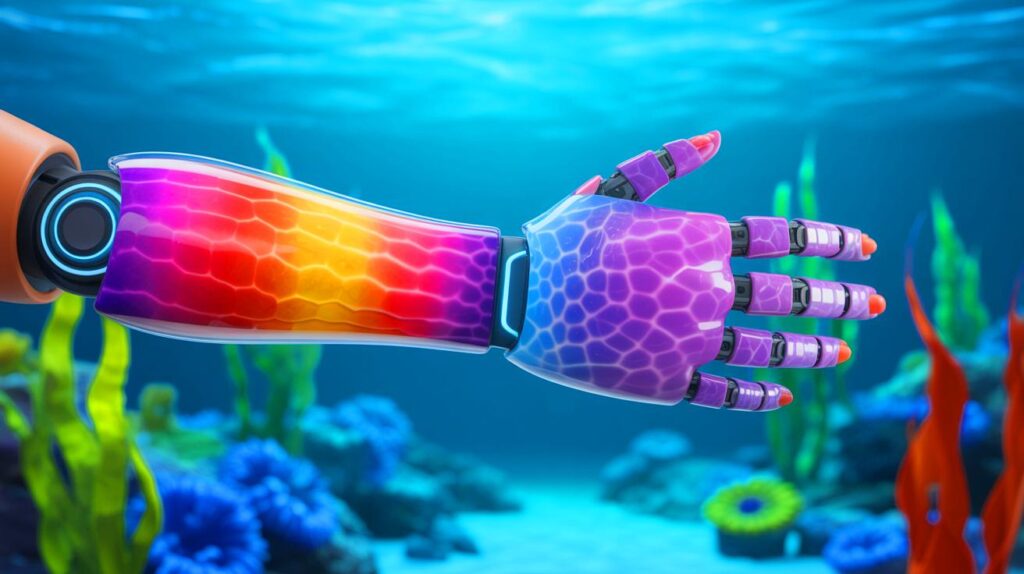A Step Closer to Emotional Machines Can We Trust Them?
In a world where technology grows at the speed of thought, scientists have taken yet another step towards blurring the lines between human and machine. Imagine a robot that doesn’t just compute or perform tasks but reacts. Not with beeps flashing screens or mechanical limbs but with something inherently human feeling.
Today, it’s no longer science fiction. New breakthroughs in color changing robotic skins have given machines an extraordinary ability to react instantly, much like living creatures. These smart skins don’t rely on wires, screens, or human instructions. Instead, they respond to their surroundings with a remarkable, organic like display of color, emotion, and awareness.
The Rise of Emotion Responsive Robots
For decades, we’ve wondered what happens when machines start to behave more like us? The idea of robots with emotions has danced through Hollywood blockbusters, philosophical debates, and tech conferences alike. But now, this vision is slowly materializing not through complex AI algorithms alone, but through biology inspired innovations like color changing skins.
These smart surfaces, crafted using advanced materials such as hydrogels, liquid crystal elastomers, and flexible polymers, mimic how living organisms like chameleons or squid change color in real time to signal emotions, temperature shifts or environmental changes. But here’s the most fascinating part: these robotic skins require no wires no screens and no external human commands. The change happens organically, as a direct response to the robot’s surroundings.
How Does This Magical Skin Work?
The secret lies in the material’s structure. Scientists have developed layers of thin, stretchable material infused with micro pigments or liquid crystals. These layers are sensitive to external stimuli such as pressure heat, touch, or even light intensity.
For example, when a robotic arm touches a hot object, the skin’s color can shift instantly turning red to signal danger, just like how human skin flushes when exposed to heat. Similarly, if a robot is under stress (mechanical or environmental), its surface might darken or change hue, visually communicating its condition without the need for screens or vocal warnings.
This evolution isn’t just cosmetic it has enormous real world applications. From search and rescue missions, where robots can display stress or damage visually, to medical robotics, where machines can react to delicate tasks with near human awareness this technology is rewriting the rulebook on human machine interaction.
The Emotional Connection: Why This Matters to Us as Humans
Humans are deeply wired to respond to visual cues. We read facial expressions, body language, and even subtle changes in skin tone to understand each other’s emotions and intentions. These color changing robotic skins tap into that same biological language, making robots appear more approachable, more relatable and dare we say more human.
This could radically improve how we interact with machines. Imagine elderly patients cared for by healthcare robots that can express comfort through soothing color changes. Picture industrial workers collaborating with robots that visually signal stress or overheating, preventing accidents before they happen.
It’s not just about function it’s about trust, empathy, and creating machines that fit seamlessly into our lives.
A Future with Feeling Machines: The Opportunities and Fears
Of course, this breakthrough stirs as much curiosity as caution. As robots become more lifelike not just in their reactions but in their ability to visually express “emotions” the lines between human and machine continue to blur.
Can a robot truly feel? Technically no. These color changes are still chemical and mechanical responses, not conscious emotions. But does that distinction matter when the machine can convincingly simulate the physical signs of feeling? To a human observer, perhaps not.
This raises profound questions:
Will we become emotionally attached to machines?
Could emotionally responsive robots manipulate us?
How do we design ethical boundaries for machines that “feel”?
The answers aren’t clear, but the conversation is more relevant than ever.
Real World Applications Already Emerging
Beyond the lab, companies and research teams are racing to integrate these smart skins into practical technologies. Some exciting developments include:
1. Medical Robots
Surgical bots equipped with color-changing skins could warn doctors of mechanical strain, temperature fluctuations, or pressure sensitivity in real time.
2. Search and Rescue Drones
Drones operating in dangerous environments could visually indicate damage or environmental hazards, improving safety for both humans and machines.
3. Assistive Robots for the Elderly
Machines that change color to signal friendliness, stress, or need for assistance could build trust and improve quality of life for vulnerable individuals.
4. Industrial Automation
Factory floor robots could visually alert workers of technical malfunctions or risks, enhancing safety protocols.
The Human Touch in a Robotic World
It’s easy to see this as yet another step towards a cold, automated future. But in reality, this innovation might bring us closer together not just human to human, but human to machine.
These responsive skins are more than a technological trick they represent our need to connect, to understand, and to build machines that don’t just serve us, but communicate with us in a way that’s natural, intuitive, and yes beautiful.
As we stand on the edge of a future filled with emotionally aware machines, one thing is clear: the goal isn’t to replace human feelings, but to bridge the gap between intelligence and empathy. Because at the end of the day, even in a world of wires, circuits and code it’s the human touch that matters most.

